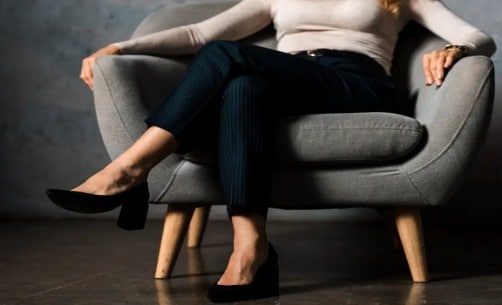The Meaning Behind Crossing One’s Legs: A Cultural and Psychological Perspective
Cultural and Social Influences
The way a person sits—especially the act of crossing one’s legs—might seem like a small, personal habit, but it’s actually shaped by cultural and social expectations, particularly for women. Across history, the posture women are expected to maintain in public spaces has reflected broader societal norms around femininity, modesty, and decorum.
In 18th-century Europe, for example, literature and art often portrayed women sitting in ways that suggested grace and gentleness. Crossing one’s legs became associated with refinement and elegance—an ideal deeply tied to how society expected women to behave. But this isn’t a global standard. In some Eastern cultures, crossing your legs may be viewed as disrespectful or dismissive, showing just how differently the same gesture can be interpreted depending on cultural context.

Even today, social expectations continue to influence how women present themselves. While crossing one’s legs may feel like a natural or comfortable way to sit, it often reflects social conditioning that encourages women to appear composed, graceful, and non-threatening. Media, fashion, and art still reinforce these expectations, shaping behaviors that might seem personal but are often socially driven. It’s important to consider how such norms impact women’s comfort and autonomy, revealing a deeper psychological complexity behind this common gesture.
Psychological Insights
From a psychological standpoint, the way someone crosses their legs can say a lot about their inner world. For some women, it’s a sign of self-confidence; for others, it may be a way to create a sense of personal space or even protect themselves emotionally in social situations.
Behavioral psychology suggests that body language—especially postures like crossing the legs—can serve as a nonverbal expression of one’s emotional state. A tightly crossed position might signal anxiety or discomfort, while a more relaxed cross could reflect ease and confidence. Psychoanalytic theories go further, suggesting that such gestures are symbolic—sometimes unconsciously linked to feelings of vulnerability or the need for self-protection.
It’s also crucial to remember that the meaning of this behavior is shaped by cultural surroundings. In one setting, crossed legs might signal elegance or modesty; in another, it might suggest withdrawal or even arrogance. These differences highlight the importance of reading body language within the appropriate cultural and social context.
Impact on Nonverbal Communication
In both personal and professional settings, nonverbal cues like crossed legs can significantly influence how someone is perceived. A person sitting with their legs crossed might come across as reserved or guarded, which can affect how open or engaged they seem in a conversation. In contrast, an open, uncrossed posture often signals confidence, attentiveness, and a willingness to connect.

Social psychologists have found that even the direction someone crosses their legs can matter. Crossing legs toward another person may suggest interest or engagement, while turning away might indicate discomfort or lack of interest.
Cultural norms also shape how we interpret these cues. In some cultures, leg crossing is a sign of respect; in others, it might be seen as too casual or even rude. Women, in particular, face different expectations when it comes to body language, and their posture is often scrutinized more closely than men’s. This can affect how their authority, confidence, and professionalism are perceived—especially in male-dominated spaces.
Broader Social Implications
Crossing one’s legs is more than just a sitting style—it’s a gesture loaded with social meaning. It can reflect long-standing gender stereotypes and impact how women are judged in everyday life. In the workplace, for instance, a woman’s posture might influence whether she’s seen as competent or authoritative. An open, grounded stance may be read as confident, while a more traditionally “feminine” posture—like crossed legs—could be misinterpreted as passive or less assertive.
As gender roles evolve, there’s growing awareness around these subtle, often outdated norms. While crossing the legs may still be seen as a classic marker of grace or elegance, it’s worth challenging the idea that women must adopt certain postures to be seen as proper or respectable.
Ultimately, understanding the psychology and cultural context behind this simple gesture can open the door to broader conversations about body language, gender equality, and self-expression. The way we sit may seem small—but it can carry big implications.


